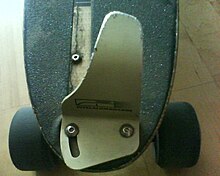Slalom board
The slalom board is a 60 to 90 cm long skateboard with slightly larger and often softer wheels (rollers).
General
Moving on a slalom board is called slalom boarding, slalom boarding or slalom skating. With a slalom board, thanks to the larger wheels and the resilient board, you can achieve much higher speeds with little effort than with a freestyle skateboard. Slalom boards allow you to increase the speed by applying pressure in the curve or on the straight road with small curves (pumps). Experienced riders can use a slalom board to reach 25–30 km / h on a flat stretch and can even negotiate slight inclines without pushing their feet off the ground.
If you want to do different tricks with the slalom board, you need so-called skyhooks, because there are no kick nose and kicktail as with street skateboarding. Skyhooks are stirrups under which you slide your feet, so you get hold of the board. They are attached above the front axle and above the rear axle. So you can perform amazing tricks with the otherwise rather heavy board and open up more possibilities to use the slalom board.
Typology
Often slalom boards are arched upwards ( convex ). So the ends of the board are deeper than the middle part.
Race-shaped slalom boards usually have a bias. This means that the board is flexible and, in addition to the wood core, has a fiberglass core. Such boards also allow pushing, but you cannot drive as tight slalom with them as with the tight slalom boards.
Tight-slalom-shaped slalom boards tend to be shorter than the race boards. They are stiff and have a shorter wheelbase. The stiffness tends to decrease a wheelbite (the rollers hit the board and block). It also helps that the energy is not lost too much in the flex (bending of the board) when pushing. The shorter wheelbase means that the axles are less far apart. This makes it possible to take tighter turns.
history
The actual (flexible) slalom board was developed in Switzerland in the early 1990s. The well-developed road infrastructure made it possible for the new board to be used as a means of transportation in the city, even over longer distances. The slalom board experienced a real boom in major Swiss cities in the mid-1990s. The boards were produced in small series by various local manufacturers and were largely Swiss-made.
processing
The slalom board is stretched on a form (a kind of template). The wood is glued standing or lying on the form. When gluing horizontally, fine layers of wood are placed on top of one another. When gluing vertically, the pieces of wood are glued next to each other. Often several layers of elastic wood are used, e.g. B. ash wood . To stabilize the board, a cover layer made of synthetic resin is often used , which is reinforced with glass , and more rarely with carbon fibers. When this process is complete, grip tape is stuck on and axles are screwed through the four holes at the front and back. The wheels usually have a diameter of 55-70 mm, which is much larger than the street skateboards. This makes them much smoother and suitable for both slalom and pushing.
Competitions
There are competitions for slalom skaters. In the parallel slalom, two drivers start at the same time after qualification. The aim is to overcome a slalom course marked out with traffic cones as quickly as possible . In the qualification the time is measured and the starting line-up is determined. Then the winner is determined according to a cup procedure. Only one driver starts at a time in the giant slalom. The border cross race is also very well known. It has banked curves, waves and a camel hump. These races are very demanding and dangerous.
Well-known big slalom competitions:
- Slalom Skateboard World Cup
- Slalom World Cup
- European Championship
- US Championship
In Switzerland, the Burning Wheels Tour was held for several years, each consisting of several racing events in which points could be collected and an overall winner was determined at the end of the season. In the first few years all races were boarder cross events, later the Burning Wheels Tour was cross-disciplinary and supplemented with slalom races, trophies (skateboard orienteering) and even downhill events.
